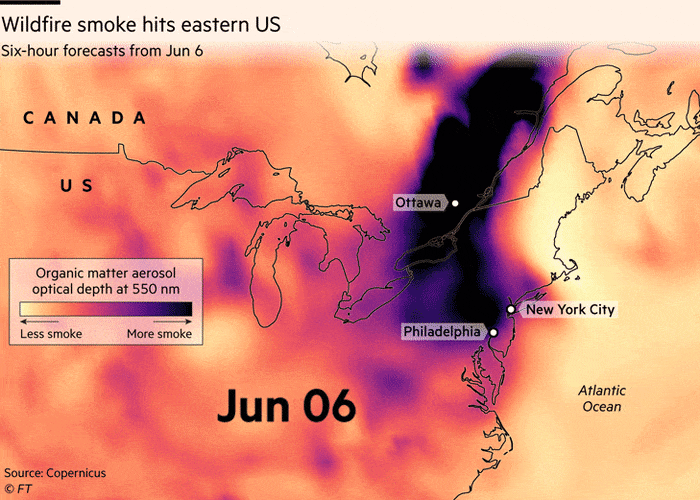Wildfire smoke makes New York air quality worst in the world
Plumes from burning Canadian forests move across North American cities and force residents indoors
Receive free Wildfires updates

We’ll send you a myFT Daily Digest email rounding up the latest Wildfires news every morning.
Thick smoke from raging Canadian forest fires has covered a swath of North America in unhealthy air, disrupting everything from air travel to Broadway shows and bringing unsettling reminders of the Covid-19 pandemic.
Authorities issued health warnings to millions of people in the eastern US and Canada on Wednesday as a cloud fed by hundreds of northern forest fires swept south, plaguing heavily populated areas from Ottawa to Washington, DC.
In New York City, the air quality ranked as the worst of any major urban area in the world on Wednesday, topping New Delhi, according to the IQAir World Air Quality index.
While forest fire air pollution has become a regular affliction on the US west coast in recent years, it has been much less common on the east coast. Residents appeared startled at its sudden and dramatic onset. Many donned face masks they had recently ditched as the coronavirus emergency had subsided.
Schools in New York and Washington cancelled outdoor activities while the US aviation regulator issued “ground delays” for flights to Philadelphia, Newark, New Jersey, and New York’s LaGuardia airports, citing “low visibility” for pilots. On Broadway, the actress Jodie Comer left the stage minutes into a matinee performance, complaining she could not breathe, and the musical Hamilton cancelled its Wednesday night show, saying the “hazardous air quality in New York City has made it impossible for a number of our artists to perform”. Major League Baseball postponed games set to be played in New York and Philadelphia.

“Yesterday, New Yorkers saw and smelled something that has never impacted us on this scale before,” Eric Adams, New York City’s mayor, said on Wednesday as an eerie fog cloaked landmarks such as the Statue of Liberty and Yankee Stadium.
Adams urged residents to remain indoors and keep their windows closed. Even if the situation improved in the coming days, Adams warned that repeat episodes were likely in the future because of climate change, saying: “While this may be the first time we’ve experienced something like this on this magnitude . . . it will not be the last.”
Canada has been battling an active wildfire season with blazes in most of its 10 provinces and its territories for most of the past month.
Canada’s environmental regulator categorised air quality in Ottawa, the country’s capital, as reaching the highest level of health risk. Large swaths of Quebec and Ontario were subject to an air-quality alert from Canadian authorities.
Earlier this spring, fires in Canada’s main oil-producing province of Alberta forced tens of thousands of people to evacuate their homes, and caused more than a dozen oil and gas companies to temporarily shut or curtail operations.

More blazes have now taken hold in the forests of eastern provinces such as Quebec and Nova Scotia. More than 400 fires were active across Canada as of Wednesday, with about 4mn hectares burnt this year, according to the Canadian Interagency Forest Fire Centre.
Scientists have observed fires in the boreal forests of the northern hemisphere increasing in intensity over the past decade, with average temperatures across the north of the planet rising faster than closer to the equator as a result of global warming, as the reflective snow and ice of the Arctic has melted away.
Wildfires north of the equator are generally becoming more frequent and intense as the planet warms and summers become hotter. May 2023 ranked globally as the second-warmest May on record, according to the Copernicus EU observation service.
Heat records have been broken in parts of Asia, in particular in China and Vietnam, where the unusually warm weather began months ahead of the usual July and August summer. Parts of Siberia also set all-time records last week.
Sea surface temperatures were the highest on record for the month and have been at near-record levels since March.
Where climate change meets business, markets and politics. Explore the FT’s coverage here.
Are you curious about the FT’s environmental sustainability commitments? Find out more about our science-based targets here



























































